Arm's New Cortex-A78 and Cortex-X1 Microarchitectures: An Efficiency and Performance Divergence
by Andrei Frumusanu on May 26, 2020 9:00 AM EST- Posted in
- SoCs
- CPUs
- Arm
- Smartphones
- Mobile
- GPUs
- Cortex
- Cortex A78
- Cortex X1
- Mali G78
Performance & Power Projections: Best of Both Worlds
We quickly looked at some projected figures at the start of the article, but now that we've had a chance to dig through the new CPUs, let's more precisely define the expected performance, power and area gains that the new Cortex-A78 and X1 cores are supposed to achieve.
Starting off with the Cortex-A78, the first comparison figures here are meant to represent the generational improvements the A78 would achieve in a target 2021 system on a TSMC N5 node. So the figures here contain both the microarchitectural gains as well as the expected process node improvements.
In terms of performance, at an ISO-power target of 1W for a core, Arm says that an A78 implementation would bring with it a 20% increase in performance, which is a healthy upgrade. A 2.6GHz A77 here on N7 here grossly matches the MediaTek Dimensity 1000(+), and the 1W power figure also roughly matches the power I’ve measured on that SoC.
Meanwhile at an ISO-performance comparison, the A78 would be able to halve the power and energy consumption compared to a 2.3GHz A77 on N7. This comparison is likely aimed at various mid-core implementations out there in the market, it is a bit of an arbitrary comparison but Arm also showcases some better figures we’ll go over in just a bit.
When actually looking at an ISO-process node comparison with a similar core configuration (essentially what Arm expects to be most commonly implemented), we’re seeing the A78 improve performance by roughly 7% over a Cortex-A77, all while reducing power by 4% and reducing area by 4%. It’s again important to note that while these figures sound maybe a little timid, Arm’s projected figures here do showcase an A78 with a lower-bounds configuration such as only 32KB L1D and L1I caches. I think the best way to interpret these numbers is to assume that this would be an implementation vendors would use to implement as their middle performance cores, leaving the higher perf targets for the X1.
Interestingly, Arm here for the first time ever published a whole performance/power curve of a microarchitecture, comparing the A77 to the A78. We see the higher cost at higher operating frequencies and the quadratic increase in power with increased voltage that is required to reach those higher frequencies (P = f * V²).
At the same peak performance point the A77 was able to achieve, the new A78 would use up 36% less power. At a more intermediate performance level (I think they might be using the process’ nominal voltage point here), this power reduction would be 30%. Finally, at the same power level, the A78 can increase performance by 7%.
Moving onto the Cortex-X1, the generational performance improvements here are a lot more impressive, and we’re seeing an increase of +30% in terms of peak performance at the same frequencies versus the A77. This comparison would actually be a maximally configured X1 versus a maximally configured A77. It's to be noted that we never saw a 3GHz A77 by vendors, meaning the real-world performance boost would actually be even bigger than this (I’m actually expecting vendors to finally hit that 3GHz target this time around, on 5nm, fingers crossed).
The 30% IPC improvements versus the A77 cover both integer and floating-point suites of SPEC2006, which is extremely impressive. Arm also showcased Stream bandwidth improvements as well as Octane performance boosts, although I don’t find these to be quite as relevant, although they do serve as pointers of what to expect of the microarchitectures in such workloads.
Arm was relatively vague on the power and area efficiency of the X1, quoting that they aren’t quite as public with these figures for these “custom” parts as they are with public roadmap designs such as the Cortex-A78, but I was able to figure out a few rough metrics. In terms of area, on a similar process, we should expect an X1 cores to be roughly 1.5x the size of an A78 – including the difference between maximized L1 and L2 caches. Power should also be roughly in that ballpark figure.
If vendors are able to actually do a good implementation and there aren't any bad surprises with the upcoming 5nm processes, we should be seeing something similar to these projections:
Again, as a big note – these figures are largely my own projections based on the various data-points that Arm has presented. This can end up differently in actual products, but in the past our predictions of the A76 and A77 ended up extremely close to the actual silicon, if not even pessimistically worse than what the real figures ended up at.
This generation, I do expect vendors to actually hit the 3GHz target for the Cortex-X1, as I have heard this being one of the goals the vendors are aiming to achieve for next year’s SoCs. I’m not too sure how many vendors will be doing for this for the Cortex-A78, which will more likely end up at lower clock speeds and implemented with a greater focus on power efficiency and area.
The Cortex-A78 would generally end up with the same power usage as current generation A77 products such as the Snapdragon 865 – with the vendors possibly using the process gains to get the last hundred MHz required to reach the 3GHz mark. The performance projection here is largely based on Arm’s +7% performance boost as well as a small clock boost. It would be a respectable upgrade, but nothing too earth-shattering in terms of generational updates.
The performance bump of an X1 system would be extremely competitive here, essentially being 37% faster than a Snapdragon 865 SoC today. That’s a huge generational bump and would put Arm very much in distance of Apple’s A13 cores, although in reality its competition would be the upcoming A14.
What’s really shocking here is how close Arm would be getting to Intel and AMD’s current best desktop systems in terms of performance. If both incumbent x86 vendors weren’t already worried about Arm’s yearly rate of improvement over the last few generations, they should outright panic at these figures if they actually materialize – and I do expect them to materialize.
The Cortex-X1 here is projected to use 1.5x the power of an A78. This might end up slightly lower but I’m being overly cautious here and prefer to be on the more pessimistic side. Here’s the real kicker though: the X1 could very well use up to 2x the power of a Cortex-A77/A78 and it would still be able to compete with Apple’s cores in terms of energy efficiency – the core’s increased performance largely makes up for its increased power draw, meaning its energy efficiency at the projected power would roughly only be 23% worse than an A78, and only 11-14% worse than say a current generation Snapdragon 865. Arm has such a big leeway in power efficiency at the moment that I just don’t see any scenario where the X1 would end up disappointing.
For years we’ve wanted Arm to finally go for no-compromise performance, and the Cortex-X1 is seemingly exactly that. That’s really exciting.


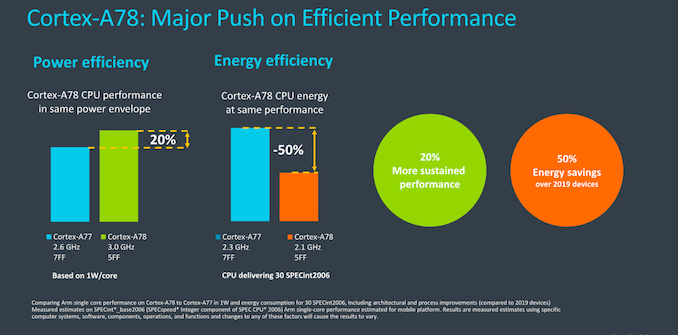
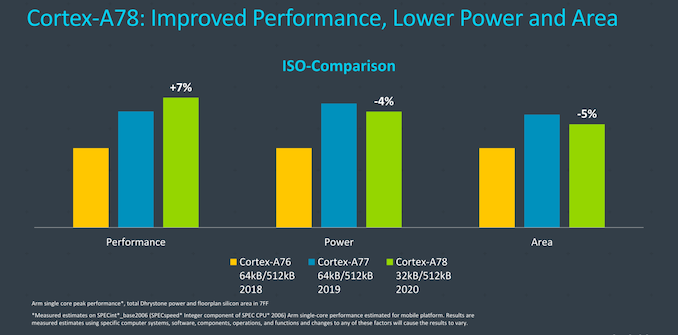

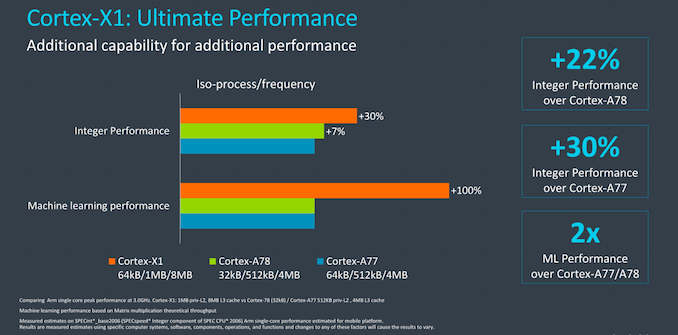
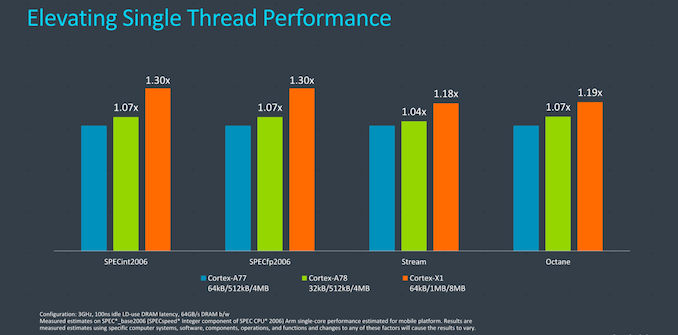
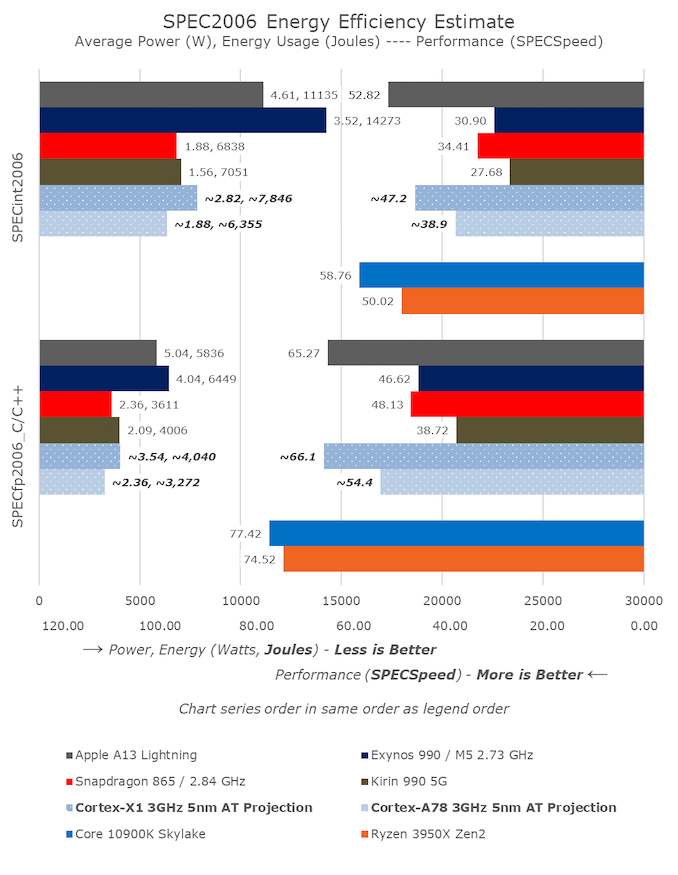








192 Comments
View All Comments
deil - Tuesday, March 30, 2021 - link
Apple love to exaggerate and use perfect scenarios. 2x faster IF you take 250$ snap model like (4XX) series and 700$ iphone. I digged though their comparisons and each of them mention worst care for others and best for them. Most of iphones dont have even 20% lead in raw performance, all it gains is efficient OS, while android is bulky and slow.another example was m1 mentioned 5x faster than "similar sized most popular laptop" which by amazon was 269$ laptop with ryzen 3200u, dated low end offering which had ~4000 points in benches when marked already had 4700u's in same form factor with 20000 points.
when comparing 300$ vs 900$ laptops, it really might look like m1 is so godlike.
FreckledTrout - Tuesday, May 26, 2020 - link
Interesting move. Can we assume the choice to keep the pipeline fairly short means ARM are targeting tablet/phones with this design?skavi - Tuesday, May 26, 2020 - link
were you expecting it to target desktop?Kangal - Tuesday, May 26, 2020 - link
It would've been nice. Remember back in 2016 ARM had a clean three tier offering:Cortex A35 - Ultra-low power
Cortex A53 - Low power
Cortex A73 - Medium power
I was hoping a similar thing to happen. Maybe it will come on a new architecture-branch, ergo ARMv9, maybe in 2022. Perhaps they can look into cores for laptops, desktops, servers. For instance:
ARM v9 Cortex A41 - Ultra-low power, same as A55 perf.
ARM v9 Cortex A61 - Low power, same as A73 perf.
ARM v9 Cortex A81 - Medium power, beyond Apple A14 perf.
Although, a big part will be optimisations and implementing a new InfinityFabric, big.LITTLE, DynamIQ style platform that scales from wearables to desktop.
SarahKerrigan - Tuesday, May 26, 2020 - link
A78 looks like another A73 - modest perf gains, but improved efficiency. X1 is fascinating; I wasn't expecting to see an aggressive design like that until Matterhorn.vladx - Tuesday, May 26, 2020 - link
Cortex-A73 had in fact lower IPC than Cortex-A72, which is not the case here with Cortex-A78.tipoo - Tuesday, May 26, 2020 - link
Page 2's index should read A78 rather than A77, I believe :)MrCommunistGen - Tuesday, May 26, 2020 - link
Thanks for fixing Andrei/team!eastcoast_pete - Tuesday, May 26, 2020 - link
Agree that this is an interesting move, both design- and strategy-wise. While the Hera (X1) core will make a great single top performance core (1x Fast+Big, 3xBig, 4xLittle) for upcoming mobile Snapdragons and Exynos SoCs, I am also curious how Hera will boost the efforts of QC and Samsung for Windows-on-Arm CPUs.The one big fly in ARM's ointment is that they apparently still believe that their A55 remains the greatest Little core they've designed to date. Isn't that design getting a bit dated, especially compared with Apple's efficiency cores, which Apple does manage to update quite regularly? What's up with that? Any information or rumors on an A57 or A58?
SarahKerrigan - Tuesday, May 26, 2020 - link
As far as I know, there's going to be a new little core announced alongside Matterhorn next year.